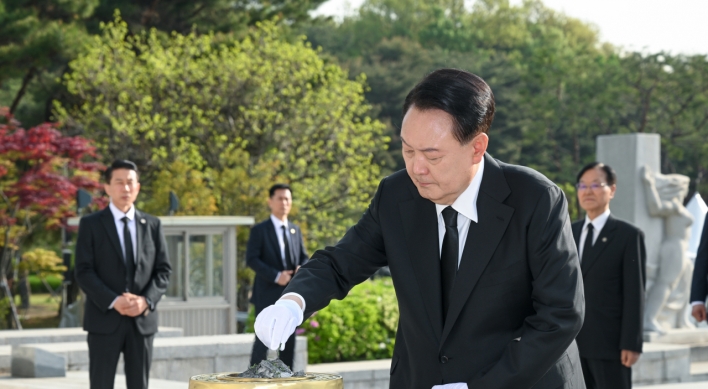[Garrett Ehinger] We need treaties on biological labs
By Korea HeraldPublished : May 24, 2023 - 05:31

The conflict in Sudan suddenly drew new levels of alarm when hostile forces in the capital city of Khartoum seized a biological research lab containing lethal viruses such as cholera, measles and polio.
It is unclear whether the viruses will be properly contained by the occupying soldiers, or if they will somehow be released and cause new outbreaks. Scenarios like these could have been avoided if there were proper prophylactic measures in place, such as treaties and disincentives.
Fighting in Sudan between the military and a paramilitary group has knocked out power for hospitals and laboratories, blocked medical and lab supply routes, and expelled vast numbers of health care professionals and researchers. Combine this dearth of supplies and expertise with the lack of sanitization faced by hundreds of thousands of refugees living or moving in dense bodies over large distances, and it’s no wonder deadly diseases like tuberculosis or typhoid fever are spreading like wildfire among these groups.
Sudan is vulnerable to contagious diseases, for example, with a high burden of malaria. The health care system established during the conflict is stretched to its limits, and the presence of combatants in biological facilities without biomedical safety training poses a new threat. If a disease like cholera or polio is released from these facilities, it could cause a health crisis.
Sudan is not alone in this risk. Ukraine has had multiple biological research facilities fall under Russian control in risky operations that could have unleashed horrible diseases upon thousands of people. And while the US denies Chinese and Russian accusations of these labs containing bioweapons and insists they were only for biodefense research purposes, the idea of any biodefense or bioweapons research facility coming under fire in wartime is even more chilling.
Obvious questions arise: Why are these facilities being constructed and operated in or around areas at risk of war in the first place? And how can we mitigate the risk of an outbreak from such facilities during wartime?
Some of these facilities are built to be near disease outbreaks -- for convenience and rapidity. For example, the World Health Organization operates several Ebola research facilities in the Democratic Republic of Congo, the Central African Republic and Nigeria, all of which struggle with Ebola and civil unrest.
Other facilities, such as those focused on public health like Sudan’s aforementioned National Public Health Laboratory in Khartoum, are vital to the countries’ fledgling public health development and so prefer to remain in urban or suburban areas where they have expedited access to resources and personnel. Unfortunately, conflict also tends to follow population centers, exposing these facilities to dangerous situations.
While the reasons for where these facilities are located can be legitimate, the risks to their placement stay the same: outbreaks that could cripple containment efforts and have potentially international effects. One way to address this risk could be for the WHO to identify “red zones,” or places that have been assessed as too risky for dangerous pathogen research as is done at biosafety level three or four labs.
Publicly declaring areas unfit for biological research of a certain virulence could disincentivize foreign players from taking a risk with research there lest they taint their names by looking irresponsible.
However, it would be unjust to strip developing nations of their right to form public health institutions lest we trap them in a limbo state of development. As such, it is not possible to stop all biological research from taking place in risk-prone areas.
Therefore, the best bet is to establish norms against attacking biological research facilities through international treaties. For example, India and Pakistan formed a “nonattack agreement” as an extension to existing articles from the Geneva Conventions that prohibited the attack of nuclear facilities in the event of war, so as to avoid radiation disasters.
Similar amendments could be made to existing treaties like the Biological Weapons Convention, and penalties meted out to violators.
Nonaggression pacts against biological research facilities could strengthen deteriorating norms against using biological weapons. In areas with fragile peace such as Taiwan, potential aggressors like China may be motivated to use bioweapons to overcome strategic or geographic obstacles.
A stipulation in the Biological Weapons Convention that prohibits attacks on such facilities could further legitimize the treaty and reinforce the international commitment to prevent and condemn any conflict that risks disease outbreaks.
The United States has a powerful voice in the United Nations and would be the best actor equipped to spearhead the proposal of such an amendment. Bolstering the perception of international commitments could deter countries like China from using biological weapons against potential targets.
Garrett Ehinger
Garrett Ehinger, a China analyst, formerly worked as the director of a biodefense research lab and as director of the Chinese Language Labs at Brigham Young University in Idaho. He wrote this for the Chicago Tribune. -- Ed.
(Tribune Content Agency)
-
Articles by Korea Herald






![[From the Scene] Monks, Buddhists hail return of remains of Buddhas](http://res.heraldm.com/phpwas/restmb_idxmake.php?idx=644&simg=/content/image/2024/04/19/20240419050617_0.jpg&u=20240419175937)





![[Graphic News] French bulldog most popular breed in US, Maltese most popular in Korea](http://res.heraldm.com/phpwas/restmb_idxmake.php?idx=644&simg=/content/image/2024/04/18/20240418050864_0.gif&u=)



![[From the Scene] Monks, Buddhists hail return of remains of Buddhas](http://res.heraldm.com/phpwas/restmb_idxmake.php?idx=652&simg=/content/image/2024/04/19/20240419050617_0.jpg&u=20240419175937)

![[KH Explains] Hyundai's full hybrid edge to pay off amid slow transition to pure EVs](http://res.heraldm.com/phpwas/restmb_idxmake.php?idx=652&simg=/content/image/2024/04/18/20240418050645_0.jpg&u=20240419100350)

![[Today’s K-pop] Illit drops debut single remix](http://res.heraldm.com/phpwas/restmb_idxmake.php?idx=642&simg=/content/image/2024/04/19/20240419050612_0.jpg&u=)